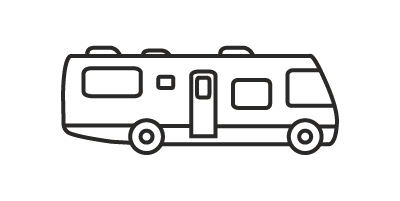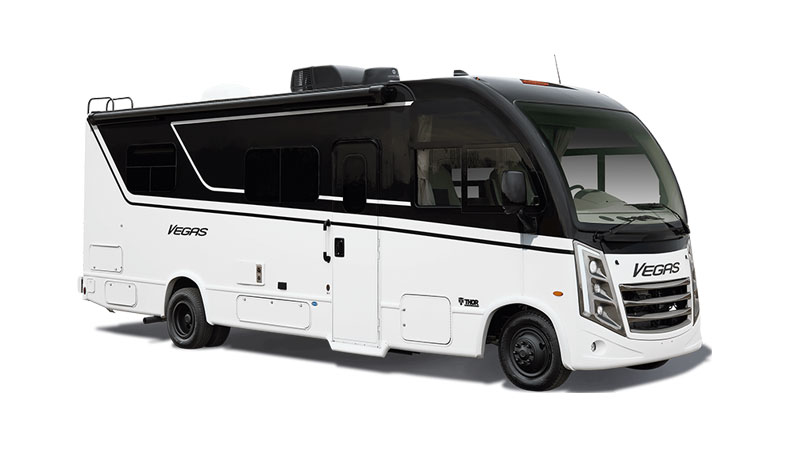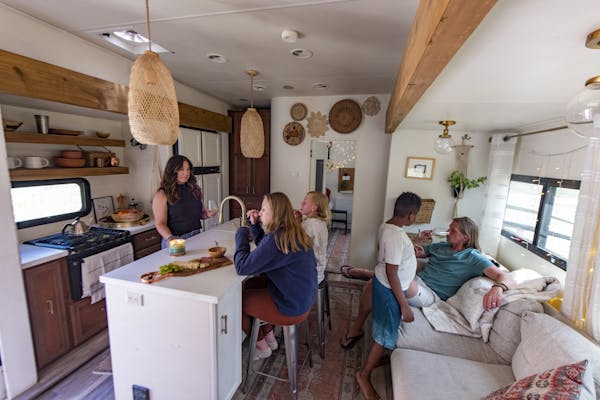What better way to connect with fellow RVers than at a group RV campout? Our family has been hosting fun-filled campouts and group RV trips for five years. Sometimes the trips are more formal—we book the campgrounds, plan the activities and meals, and coordinate all of the logistical details. Other times, we simply pick a destination, everyone books their own campsite and shows up. Either way, the goal for these trips is always the same: Foster a sense of community, connect with others and share our love of the outdoors.
After planning and coordinating many different group RV trips, we’ve learned a few things along the way. Here are our five steps for planning the perfect group RV trip.
STEP 1
Research the Destination and Campground
When deciding on a destination for our group trip, there are a few things we always look at. First, we try to prioritize places that have some natural beauty and character. We like to treat these trips as vacations or getaways, so it’s always nice to be surrounded by natural beauty. Second, we make sure the location can accommodate a large group and a variety of RV types (ideally 12-15 sites), is family-friendly, and allows pets. Looking for sites with full or partial hook-ups is also ideal since not everyone has the same camping style or comfort level. And lastly, we try to find a location that offers a variety of outdoor recreation or activities. We’ll look for things like kayaking, biking, hiking, horseback riding, even Jeep or ATV tours.
STEP 2
Reserving Campsites
Due to the size of our group, the different lengths of the RVs, and wanting to have full or partial hook-ups, we book our campsites anywhere from nine to 12 months in advance. The farther ahead you book, the more options you’re likely to have. We’ve found that private campgrounds and campground networks like KOA are more accommodating when it comes to reserving multiple campsites. When you do book multiple sites, ask about group discounts or see if the campground offers any lock-in fees. Lock-in fees may cost extra but it helps guarantee your campsites and offers peace of mind down the road. It’s always a good idea to ask about a campground’s cancellation policy and see if there is any flexibility, especially when you’re booking almost a year in advance.

STEP 3
Announcement
After we’ve found the location and booked the campsites, we send out an announcement with pertinent information, including:
- Trip Dates
- Location / City
- Name of the Campground
- Cancellation Policy
- Number of Available Campsites
- Types of Activities Planned
We ask people to sign up and pay a deposit by a specific time. After the initial list has been filled, we will then start a waitlist. A lot can happen when planning an event that is months and months away, so we try to stay flexible and understanding.
Whenever we’re organizing a group trip, we’ve found that it’s best to be transparent, clear and engaging throughout the process. Some members of the group may be meeting for the first time or going on their very first RV trip, and they might feel nervous and apprehensive. Regularly communicating essential details about the trip can help ease the anxiety for any new or shy members and make the activities more inclusive.
STEP 4
Planning Activities
We always try to plan a variety of activities to ensure there is something for everyone. Some of our most memorable activities include off-roading in Death Valley, a Jeep tour in Sedona, hiking the Narrows at Zion, kayaking at Morro Bay, and horseback riding in Mammoth. The best piece of advice for planning group activities is to book as far in advance as possible. Research the area you’ll be staying at and see what activities are popular there. But don’t feel like you need to pack your schedule with activities—it’s important to have some downtime for people to relax and connect.
None of the activities we plan are mandatory but we do ask that people try to attend one of our potluck dinners. These dinners are a great way to connect with others, pitch in and bring the group together. Giving the dinners a theme, such as “taco night" or “famous dishes from your homeland,” makes it more fun and allows people to try new things. We also can’t forget about the kids! When the kids are entertained, the parents can relax and have their own fun. Cornhole, Giant Jenga, bocce ball, and outdoor movies are great campsite activities for kids of all ages.

STEP 5
Pre-Campout
A few weeks before the trip, we collect the remainder of the campsite fees and assign everyone their specific spot. When assigning spots, we like to put the families with kids next to one another and closer to the host. The host serves as the central point of the group, where all of the members can get together, hang out and have meals. Putting families near this central point not only allows the kids to interact more but it also helps the parents relax knowing their kids are nearby, especially at night. We’ve also noticed that people without kids tend to enjoy more quietness and solitude, so we’ll place them farther away from the host. However, everyone enjoys each other’s company and gathers at the host site daily.
During this time, we’ll also send out potluck sign-ups, housekeeping reminders, and updates on weather and road conditions. It’s important to note the weather, as this dictates what people will bring with them.
The last step is to start a group chat or group email for everyone who will be joining. This is a fun way for people to start to get to know each other. It’s also convenient for sending out updates or changes, as well as things like arrival times.
ARRIVAL
Let The Fun Begin
The arrival day is always filled with excitement and anticipation. We meet up with old friends and greet new ones. Even though we plan lots of fun activities, we still enjoy downtime around the campfire and at the campground. Having a well-planned and coordinated trip allows us to have more fun and enjoy more camaraderie while we’re there. Thoughtful planning and communication helps decrease stress and misunderstandings during the trip. And once the trip is over, we always share pictures, thank our contributors, reflect on the time together, and continue to bond with the group. Then, we get ready to start planning the next group RV trip!











